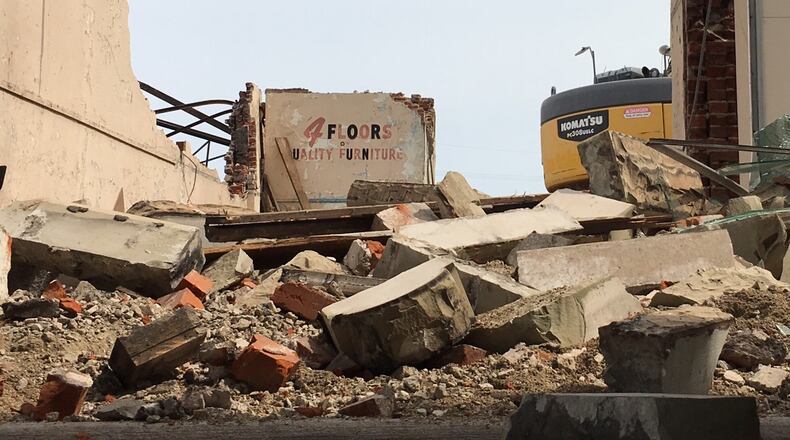Dingeldein in July explained it would be cost-prohibitive to leave the facade standing while tearing down the rest of the building, mostly for insurance reasons. But he committed instead to taking the facade apart so it could be reassembled at some later date if a use for it could be found.
“The price to mark it (the facade’s pieces) and to map it, and to label it and to stack it and actually shrink-wrap it … on pallets was really reasonable,” Dingeldein told the ADRB panel, some of whose members were anguished by the prospect of seeing the former Treble Building at 216 S. Third St. razed.
Board members expressed appreciation for CORE Fund’s decision to spare the facade so it might be used again someday, even if somewhere else.
“We will execute that plan,” Dingeldein told the panel. “We will disassemble the facade and label it, and keep it onsite for hopefully a future reinstatement.”
The facade came down, but in a much more abrupt way, with the limestone pieces now amid the rubble in front of where the stone-clad Romanesque-style building used to stand.
Dingeldein said the facade will still be stored.
“It is being saved — it just can’t be saved any other way than the way it is being saved,” he said Monday. “We couln’t leave it up, standing free-standing and take it down piece by piece because it’s attached to the structure of the building.”
“And they couldn’t lay it out in the street because it would have, obviously, blocked traffic, and hurt people,” he said. “So they laid it back on top of that pile (that used to be the building), and they’re going to sort all that limestone out of that pile onto pallets, and ship it up to the city’s North water (treatment) plant for storage.”
“But there was no other way to get it down without bringing it down with the building, because it was structurally not self-standing, so it had to be demolished with the building. But it will be sorted and saved.”
“It will be a puzzle,” putting it back together again. “I don’t know if we’ll have 100 percent of the puzzle pieces or 97 percent of the puzzle pieces, but yes, all limestone will be peeled out of there, and saved, and stacked and pallet-ed.”
Nathaniel Kaelin, with CHAPS (Citizens for Historic and Preservation Services) of Butler County, which earlier in the year started a petition to save the building, said via email the organization had not developed a position on the matter.
“At this point, I do not have a coordinated response on behalf of CHAPS,” he wrote. “We do have members that are concerned about the manner in which the facade was taken down. Given the age, size, and detail of some of the facade pieces, it seems likely that there was probably significant damage to the stone. If there is significant damage, it would be unfortunate as the chosen manner seems to vary from the orderly deconstruction that was originally proposed.”
Margo Warminski, preservation director for the Cincinnati Preservation Association, said maintaining or stabilizing a building, “especially a key building like the Joffe” building, often yields a better return on investment than demolition.
“Saving a facade (sometimes called a “facadectomy”) is a last-chance option: expensive, invasive, requiring tricky engineering to work,” she added. “Unfortunately some dismantled facades put in storage never again see the light of day. If saving them in situations didn’t make sense before, it likely won’t make sense later.”
“If pieces are not numbered, reassembling the front will be more difficult,” she added.
On the other hand, “Good things are already happening around the site — we hope some new development will fill in the vacant space and add new life to the street,” she said.
About the Author
